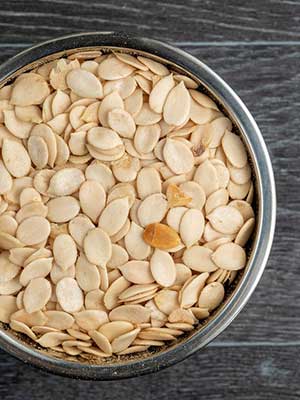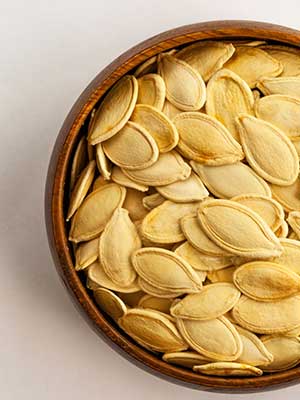
Fat (Per 100 gr)
49 g
Calories (Per 100 gr)
559 Kcal
Carbs (Per 100 gr)
11 g
Chol (Per 100 gr)
0 mg
Introducing the seeds and their value!
The seed is a food that is found in all homes and has many fans, this popular food has many properties that we all mention in this article. Tokhme, like fish, are omega-rich. Omega-3s in eggs help reduce heart rate abnormalities, blood triglycerides, the risks of clot formation, the speed of atherosclerosis. the risk of hypertension and the reduction of cancer and behavioral disorders in young people and they are not any known side effects of them (if consumed adequately)
They are a rich source of fat that when they mature, they lose a lot of their starch and increase in fat. In terms of fat, they also contain both saturated and unsaturated fatty acids, but the amount of unsaturated (useful) fatty acids is higher.

Consumption in Iran
The important status of seeds in the traditional and ancient culture of Iran
seeds and nuts have become one of the symbols of Iranian culture from a long time ago. Iranian people consume them usually in social gatherings and ceremonies and also festivals like the Iranian new year (Nowrooz).
Status in the religious culture of Iran
In many religious ceremonies in Iran, they traditionally used seeds and nuts, although not approved by any religious authority, people believe they can solve their problems with the help of some of them.
The economic value: Iranian seeds and nuts are one of the well-known examples of Iranian exports in world markets.
Processing Methods:
- frying
Mostly it contains seeds and nuts that are soft or have softer skin such as watermelon and pumpkin.
- Roasting
Including nuts that have hard skin, such as sunflower and Japanese.
Different Steps in Launching the Seeds Production Line
The methods of processing seeds are as follows:
Initially, they pour them into the container called Hopper, which is driven by a conveyor to the Roaster or Fryer. depending on the type and how they are processed. As mentioned above, there are two types of seed in the production line, and at the beginning, the companies process nuts from one of these two methods.
- Frying section
- Roasting or Topping Line
The next step is to add spices, flavors, and preservatives to them, which vary depending on which frying or roasting methods are using. within the roasting process, after the seeds are roasted, the roasted ones are added to the desired flavors and fried again in another roaster at a lower temperature."
And in the frying method, after the nuts have come out of the fryer and cooled. they are passed through the spice machine and impregnated with the desired flavoring powder. Finally, according to your desired weight, flavored processed seeds are packaged in a variety of shapes, (large, regular, single, or small).
Processing Methods: Flavor the seeds through the Roasting Line
The dominant taste in the roasting seeds is salt. When roasting a seed, the temperature is high and any other spices except salt (such as saffron) are used. at high temperatures, it is heated and only the salt retains its flavor. The question may arise: how do seeds like sunflower taste like lemon juice etc? how they taste? Better to know that sunflower or watermelon seeds are flavored with lemon juice, angelica, etc. after baking based on customer demands. That is after the seeds come out of the Roaster. they add the desired flavor and roast again from another roaster at a lower temperature of about 90 degrees (at this temperature the flavor does not dissipate).

Keeping seeds in the room or the fridge? Which is correct?
Cleansed seeds and nuts are prone to moisture and odor, and if not properly maintained, pests will grow from them.
Important points in keeping the nuts:
"Nuts and seeds are prone to moisture and odor," said a food and nutrition expert. "Nuts and seeds are prone to moisture and odor. and if they are not properly maintained, they will be rotted.”
"The shelf life of seeds and nuts at room temperature is lower than the refrigerator temperature and they can be stored for more than a few months at room temperature." said the doctor, noting that the duration of the freshness of seeds and nuts depends on ambient temperature and humidity. If not maintained properly, they will lose their quality.
If you want to keep nuts at room temperature, it is best to put them in the freezer for 4 hours to eliminate the possible larvae in them.
"When storing seed and nuts at room temperature, they should be kept in plastic or glass containers and resistant to light and moisture and odor," he said. Asked whether spicy walnuts are harmful to health, he said, "Walnuts that have spicy oil and flavor are not harmful to health."
"To keep the quality and nutritional value of seeds, keep them in their hard shell and avoid buying pistachios," he said. Most of them can be stored in the refrigerator for a year, preferably with the skin, and can be stored in the freezer for one to three years. To maximize the nutrition and taste of the nut kernels, it is best to prepare them as needed. and eat them freshly as these products will smell like other foods in the refrigerator over time. And their taste becomes unpleasant.
-
1
Planting
February, March, April
-
2
Harvesting
July, August
Types of seeds in Iran and description and introduction of each

-
Sunflower: Energy boosters!
Sunflower Seeds are high in phosphorus, manganese, zinc, potassium, magnesium, iron and contain significant amounts of folate, vitamin B, and other B vitamins that cause these vitamins. The body can be good at using carbohydrates and being energetic. A handful of sunflower seeds provides 55% of the thiamine, or vitamin B1, needed daily for the body.
Sunflower seeds are high in polyunsaturated fatty acids, especially linoleic acid, which is an omega-3 fatty acid. Besides, these delicious nuts also contain monounsaturated fatty acids, which are extremely beneficial for cardiovascular health. A handful of these seeds provide about 90 percent of your daily requirement for vitamin E. 100 grams of sunflower seed contains 580 calories of energy. It contains 24% protein, 47% oil, 20% carbohydrate and is high in phosphorus, potassium, iron, calcium, magnesium, and vitamins A, B, and E.
-
Watermelon: The enemy of osteoporosis
100 gram of watermelon seeds has 590 calories of energy and 10 of them contain 5 calories of energy. The compounds found in this seed are similar to other types and its proper and balanced consumption can prevent anemia, anorexia, malabsorption, and inflammation. This seed is more commonly known as jabani (Japanese) seed and its calcium may be useful for postmenopausal women in preventing osteoporosis. Seedlings of various watermelon varieties are small and large and can be frying in salty, rosehip, and lemon flavors.


-
Melon: hematopoietic!
The roasted melon seed contains fat, protein, iron, vitamin E and fiber. Melon seeds are also rich in minerals and vitamins, help in blood supply and have antioxidant properties.
-
Pumpkin: Prostate Health
Eating 2 grams of pumpkin seed will provide half of your daily need for manganese, magnesium, and phosphorus. Pumpkin seeds can be good nuts for people who are exposed to osteoporosis. Also, pumpkin seeds play an anti-inflammatory role in maintaining prostate health.
Pumpkin seeds are the best source of magnesium and, according to scientists, high levels of magnesium in the blood reduce the risk of premature death by up to 5%. In the autumn, pumpkin season, you can dry the seeds and add them to your daily diet. For every 30 grams of pumpkin roasted seed, there is 150 mg of magnesium. Contrary to popular opinion, pumpkin seed is a worm repellent and enhances memory. The Iranian “Paper pumpkin seeds” are also rich in phytosterol and vitamin E and linoleic fatty acids and are using for curing prostate edema and urinary tract irritation.

Iran Seeds export destinations
Top export destinations of seed from Iran in 2017 are as follows:
- Iraq: in the amount of 66% (2.2 million US$)
- Pakistan: in the amount of 22% (740 thousand US$)
- Kuwait: in the amount of 7.5% (248 thousand US$)
- Qatar: in the amount of 1.85% (61 thousand US$)
- United Arab Emirates: with a net value of 18 thousand US$
- Kazakhstan: with a net value of 12.1 thousand US$
- Oman: with a net value of 9.15 thousand US$
- Jordan: with a net value of 6.91 thousand US$
- Afghanistan: with a net value of 5.57 thousand US$
- Lebanon: with a net value of 1.62 thousand US$
